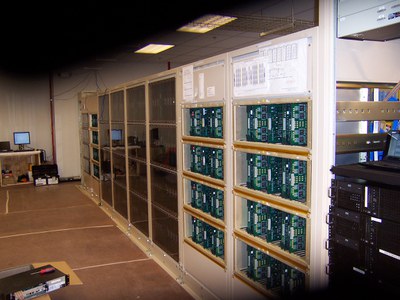Digital Signal Processing - Phasing up ALMA

ALMA Correlator at the Array Operations Site (AOS). The 64-antenna correlator processes 16 GHz from each antenna, performing 17,000,000,000,000,000 calculations per second.
During the past several years, the CDL digital group dedicated itself to the successful production and testing of the main correlator for ALMA. As part of an NSF MRI (Major Research Instrumentation) grant to Haystack Observatory, the CDL has now begun to update the main ALMA correlator so that it can participate in phasing the antennas for VLBI operation . New hardware, firmware and FPGA (Field Programmable Gate Array) personalities will be designed, and similar existing components will be modified. The long term goal is to provide a phased-antenna data-recording capability for ALMA. Among other exciting science, this will help realize the “Event Horizon Telescope”, which will be able to image the black hole at the center of our galaxy with angular resolution comparable to the event horizon. In the next year, NRAO’s goals include completing the design and testing of the new correlator hardware as well as an intricate test fixture with which to test it.
CDL DSP Development Areas:
- Upgrade ALMA correlator for VLBI capability as part of Event Horizon Telescope (EHT) project
- Develop wideband beamformers for phased array feeds
- Develop new firmware and GPU algorithms for science-specific applications, such as pulsar search and timing
- Develop high-speed digital links for receivers to central processing stations

ALMA Correlator board. Each board contains 64 correlator chips, with each chip correlating 4 antennas at a 125 MHZ clock rate.




Connect with NRAO